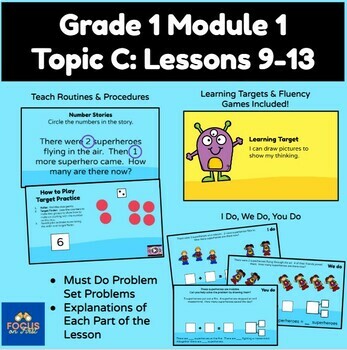First Grade Module 1 Lessons 9-13 Original Eureka Aligned
Focus on 1st
167 Followers
Grade Levels
1st
Subjects
Resource Type
Standards
CCSS1.OA.A.1
CCSS1.OA.A.2
CCSS1.OA.B.3
CCSS1.OA.C.5
CCSS1.OA.C.6
Formats Included
- Google Drive™ folder
Pages
200+
Focus on 1st
167 Followers

Made for Google Drive™
This resource can be used by students on Google Drive or Google Classroom. To access this resource, you’ll need to allow TPT to add it to your Google Drive. See our FAQ and Privacy Policy for more information.
What educators are saying
These slides allow me to move through the lesson efficiently. My students like the timers and images that go with the lesson and appreciate the routines.
Also included in
- **Please Note: These lessons are not exact copies of the lesson script. This is my interpretation of these lessons using an I Do, We Do, You Do model. Each lesson has been backwards planned using the Exit Ticket to determine which skills should be emphasized. Learning Target, Concept DevelopmentPrice $36.00Original Price $36.00
- SIMPLIFIED, STUDENT FRIENDLY LESSON SLIDES!Grade 1 Modules 1-3 ALL LESSONSIndividual PPT presentation for each lessonRoutines and Procedures for: Finding the Right Page, Sprints, Number Bond Dash, Application Problem, Problem Set Must Do Problems, and More.Fluency ActivitiesApplication ProblemConcepPrice $72.90Original Price $78.00Save $5.10
Description
Grade 1 Module 1 Topic C Lessons 9-13:
- Individual PPT presentation for each lesson
- Routines and Procedures for: Finding the Right Page, Sprints, Number Bond Dash, Application Problem, Problem Set Must Do Problems, and More.
- Fluency Activities with Animated Games and Directions
- Application Problem with Reflection and Extensions
- Concept Development with I Do, We Do, You Do
- Learning Target and Success Criteria Introduced and Revisited
- Problem Set with Must Do Problems aligned with Exit Tickets
- Reflection
- Exit Ticket with Timer and Learning Target Review
Also includes notes about procedures, routine, and setup to help teachers more effectively teach math Lessons.
Student friendly version of this popular math curriculum allows students to have gradual release of responsibility with I Do, We Do, You Do included.
Completely editable slides allow you to customize to fit the needs of your students. Please view in Slideshow mode, as animations and layered graphics can make template look odd in editing mode.
***Interactive White Board***
- These slides are meant for use with an interactive white board, and have blank spaces for teacher modelling and student practice problems. Animations do not fill in all blanks automatically.
Total Pages
200+
Answer Key
Not Included
Teaching Duration
1 Week
Report this resource to TPT
Reported resources will be reviewed by our team. Report this resource to let us know if this resource violates TPT’s content guidelines.
Standards
to see state-specific standards (only available in the US).
CCSS1.OA.A.1
Use addition and subtraction within 20 to solve word problems involving situations of adding to, taking from, putting together, taking apart, and comparing, with unknowns in all positions, e.g., by using objects, drawings, and equations with a symbol for the unknown number to represent the problem.
CCSS1.OA.A.2
Solve word problems that call for addition of three whole numbers whose sum is less than or equal to 20, e.g., by using objects, drawings, and equations with a symbol for the unknown number to represent the problem.
CCSS1.OA.B.3
Apply properties of operations as strategies to add and subtract. If 8 + 3 = 11 is known, then 3 + 8 = 11 is also known. (Commutative property of addition.) To add 2 + 6 + 4, the second two numbers can be added to make a ten, so 2 + 6 + 4 = 2 + 10 = 12. (Associative property of addition.)
CCSS1.OA.C.5
Relate counting to addition and subtraction (e.g., by counting on 2 to add 2).
CCSS1.OA.C.6
Add and subtract within 20, demonstrating fluency for addition and subtraction within 10. Use strategies such as counting on; making ten (e.g., 8 + 6 = 8 + 2 + 4 = 10 + 4 = 14); decomposing a number leading to a ten (e.g., 13 - 4 = 13 - 3 - 1 = 10 - 1 = 9); using the relationship between addition and subtraction (e.g., knowing that 8 + 4 = 12, one knows 12 - 8 = 4); and creating equivalent but easier or known sums (e.g., adding 6 + 7 by creating the known equivalent 6 + 6 + 1 = 12 + 1 = 13).







